
Palermo is a city in southern Italy, the capital of both the autonomous region of Sicily and the Metropolitan City of Palermo, the city's surrounding metropolitan province. The city is noted for its history, culture, architecture and gastronomy, playing an important role throughout much of its existence; it is over 2,700 years old. Palermo is in the northwest of the island of Sicily, by the Gulf of Palermo in the Tyrrhenian Sea.

The Victor Emmanuel II National Monument, also known as the Mole del Vittoriano or simply Vittoriano, is a large national monument built between 1885 and 1935 to honour Victor Emmanuel II, the first king of a unified Italy, in Rome, Italy. It occupies a site between the Piazza Venezia and the Capitoline Hill. It is currently managed by the Polo Museale del Lazio and is owned by the Ministry of Cultural Heritage and Activities.
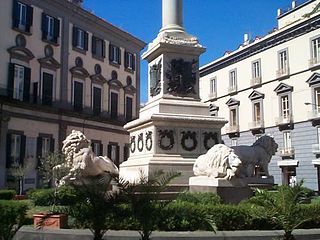
Piazza dei Martiri is a monument-containing square in Naples, Italy, located at the junction of Via Domenico Morelli and Santa Caterina, one block north of the eastern end of the large seaside park known as the Villa Comunale. The square was originally dedicated to Santa Maria a Cappella, but took on patriotic significance when Italy was united in 1861.
Quattro Canti, officially known as Piazza Vigliena, is a Baroque square in Palermo, region of Sicily, Italy. The site is the intersection of two major streets in Palermo, the Via Maqueda and the Corso Vittorio Emanuele. On the southwest corner stands the church of San Giuseppe dei Padre Teatini. A few steps away along the flank of this church, behind the Southeast corner building, along Via Maqueda is the Piazza and Fontana Pretoria, sandwiched between this church and Santa Caterina. A few more steps reaches San Cataldo and the church of La Martorana.

Mario Rutelli was an Italian sculptor.

Piazza De Ferrari is the main square of Genoa. Situated in the heart of the city between the historical and the modern center, Piazza De Ferrari is renowned for its fountain, which was restored in recent years along with a major restyling of the square.

Palazzo Isnello is an historic palazzo situated between the ancient via del Cassaro and Piazza Borsa, in the Kalsa quarter of Palermo, Sicily.

Nicosia Cathedral is the cathedral of the Roman Catholic Diocese of Nicosia, Sicily, and is located in Nicosia, Sicily, Italy. It is dedicated to Saint Nicholas of Bari. The Cathedral preserves a precious and unique wooden roof of 1300.
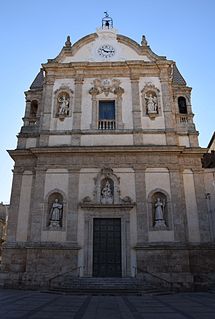
The Chiesa del Gesù is a Catholic church located in Alcamo, in the province of Trapani, Sicily, southern Italy. It is the second largest church in Alcamo, after the basilica di Santa Maria Assunta.

The Praetorian Fountain is a monumental fountain located in Piazza Pretoria in the historic center of Palermo, region of Sicily, Italy. The fountain dominates the piazza on the west flank of the church of Santa Caterina, and is one block south of the intersection of the Quattro Canti. The fountain was originally built in 1544 in Florence by Francesco Camilliani, but was sold, transferred, and reassembled in Palermo in 1574.

The Praetorian Palace, also known as Palace of the Eagles, is a palace of Palermo. The building has an important role in the political life of the city, since it houses the mayor and the offices of the municipality of Palermo. It is located in the heart of the historic centre, between Via Maqueda, Piazza Pretoria and Piazza Bellini, in the same area of other well-known architectural landmarks like the Fontana Pretoria, the Baroque church of Santa Caterina and the Medieval churches of Martorana and San Cataldo.

The Politeama Theatre is a theatre of Palermo. It is located in the central Piazza Ruggero Settimo and represents the second most important theatre of the city after the Teatro Massimo. It houses the Orchestra Sinfonica Siciliana.
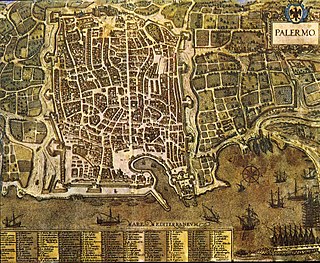
The Cassaro is the most ancient street of Palermo. From the late 16th century the street also had the name Via Toledo. Following the unification of Italy, it was officially renamed Via Vittorio Emanuele II, but the old and distinctive name is still in use. The street is rooted in the age of the foundation of Palermo by the Phoenicians. It provides access to a number of important sights, including the Royal Palace and the Cathedral, two UNESCO World Heritage Sites.
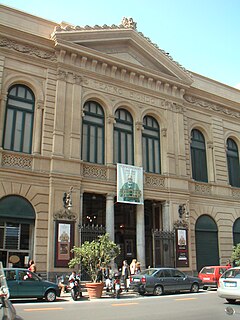
The Biondo Theatre is a neoclassical and Art Nouveau-style theater building located on Via Roma #258, corner with Via Venezia, in the ancient quarter of Castellamare of central Palermo, region of Sicily, Italy. Diagonally across Via Roma is the ancient church of Sant'Antonio Abate and a stairwell descending into the warrens of the Vucciria Market.

Sant'Eulalia dei Catalani is a deconsecrated church, whose Renaissance facade can still be seen on Via Argenteria #19, at the edge of the lively Vucciria market in ancient quarter of Castellammare in central Palermo, region of Sicily, Italy. In a niche in the small piazza in front of the church is a statue of the Genius of Palermo, sculpted by Pietro di Bonitate in 1483, and now called Palermu lu Grandi.

Giovanni Emanuele Bidera was an Italian writer.
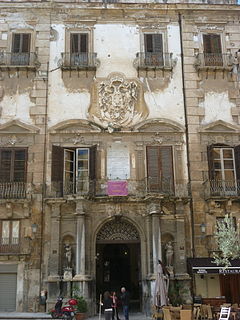
The Palazzo Alliata di Villafranca is a noble family's palace in the Palazzo Reale district of Palermo. It occupies the whole city block between the Cassaro and the back of Via dell'Università and the whole of a side of Piazza Bologni.

Giacinto Carini was a politician and Italian patriot. He participated in the Sicilian independence revolution of 1848, was a Garibaldian, a general, and a member of Parliament.
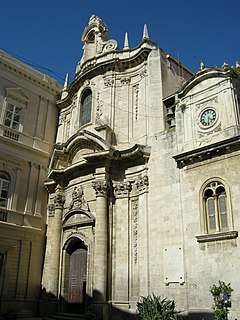
San Francesco all'Immacolata is a baroque-style, Roman Catholic church located on Piazza Francesco Corpaci on the island of Ortigia, in the historic city center of Siracusa in Sicily, Italy.



















